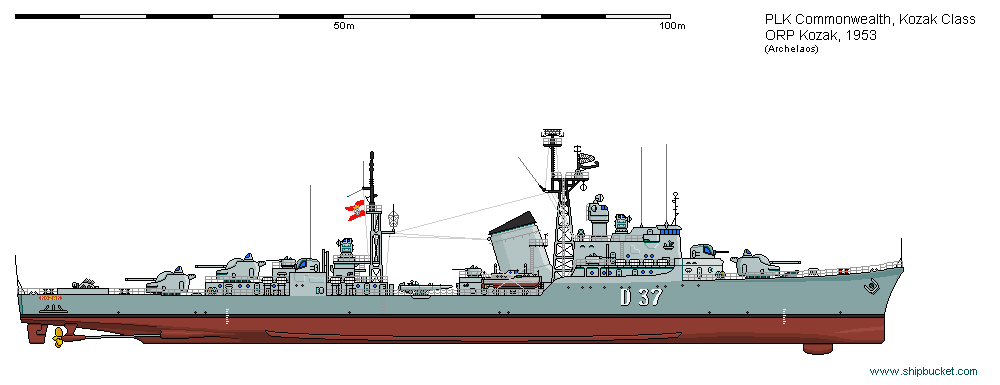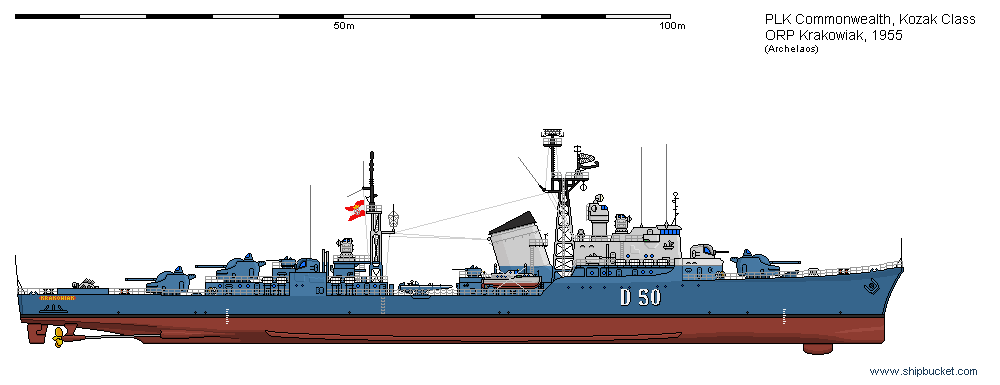PLK Commonwealth Kozak class
End of The World War (1.IX.1947) saw PLK Commonwealth severely weakened. While a simple survival of the Soviet invasion can be seen as a massive victory, just as well as the fact that threat of US nuclear bombs finally put an end to bloodshed and revived old concept of status quo peace, the war ravaged eastern half of the country, while communist sponsored rebels took control in Polish East Africa. On Madagascar rebels were contained, but civil war was to continue for many years to come. Navy, formerly pride of the state, was in tatters. Many ships were lost, but most importantly, post war reconstruction of the country forced massive cuts to naval budget. Almost all capital ships were scrapped or mothballed. Number of smaller ships was also greatly reduced and all new constructions were put on hold or cancelled. It took almost two years for the first new ones to begin. Finally, in 1949 a new class of destroyers was authorized. Ships were designed to be effective in “small war” that dominated during World War in Baltic. But they also needed to be fast enough to operate with fleet task forces at home and overseas, be able to engage land targets and hunt submarines. Drawing onto war experience, decision was made to equip those ships with strong AA battery, to help them survive in zones saturated with aircraft, like Baltic. As result of all those requirements, Kozak class ships were to be bigger than any other DD leader in PLKC Navy and by many seen as a small scout cruiser rather than typical DD.
As result, twin 12cm turrets recently developed by Cegielski Engineering were picked as main armament. Extremely advanced at the date of design, they were automatically loaded, resulting in fire ratio around 40 shells per minute. Those guns were supplemented by 3in AA guns MK33 obtained from USA and 6 newest Bofors 40mm L70 AA guns. Two triple 533mm torpedo launchers were mounted on the sides amidships. They were capable of launching various torpedoes, from well tested and reliable wz.38 and wz.43 to newest homing TNN-52A (surface targets) and TNP-51C (ASW). Usually the middle tube housed ASW torpedo.
Initially six were planned but as the fast paced progress in aviation (widespread use of jet engines) and missile technology quickly reduced importance of AA artillery, only first batch of three were finished. All of them received names of inhabitants of regions of the Commonweatlh beginning with letter K: Kozak Kaszub and Kujawiak. Second batch, planned to be laid down in 1951 were initially delayed pending reassessment and later cancelled in favor of new design. Despite that, the class was considered a success, one of the reasons being that massive, long range bombers were not what PLKC Navy feared most. Instead, a swarm of light planes attacking at low altitude was seen as a main threat, especially as Soviets shown that they are ready to sacrifice multiple pilots and planes to achieve a goal, bombing in large groups from various directions.
ORP Kozak was laid down in Royal Naval Yard in Riga in August 1949, launched in September 1950 and completed in May 1952, ORP Krakowiak was laid down in Gdańsk Naval Yard in December 1949, launched in November 1950 and completed in June 1952 finally ORP Kurlandczyk was laid down in Vickers-Ventspils in January 1950, launched in March 1951 and completed in December 1952.
Displacement: 2 733 t light; 2 866 t standard; 3 619 t normal; 4 222 t full load
Dimensions: LOA: 135,17 m / 443,49 ft Waterline: 131,83 m / 432,50 ft Beam: 12,50 m / 41,01 ft Draught: 4,26 m normal, 4,79 m deep (13,98 / 15,70 ft)
Armament: 3x2 - 4,72" / 120 mm L50 wz.50 3x2 - 3,00" / 76,2 mm L50 Mk33 2x2+2x1 - 1,57" / 40,0 mm L70 M1948 2x3 - 21,0" / 533 mm in deck mounted side rotating tubes 2 triple Squid ASW mortars
Sensors: Model 412 air search radar Model 421 surface search radar SKO-12/N GFCS 2x Mk.56 GFCS Model 147 bow sonar Model 56 HFDF
Machinery: Oil fired boilers, steam turbines, Geared drive, 2 shafts, 69 300 shp / 51 698 Kw = 35,00 kts Range 4 500nm at 20,00 kts Bunker at max displacement = 1 357 tons
ORP Krakowiak in Overseas Pattern 44, during her deployment in the Far East

